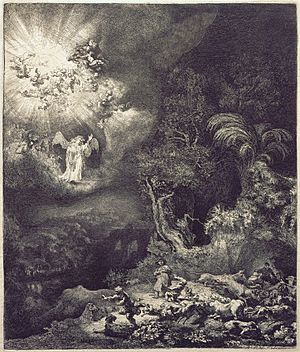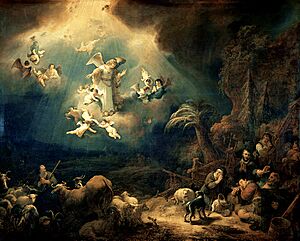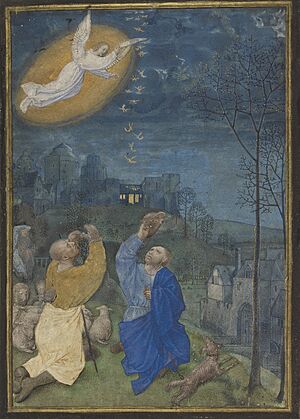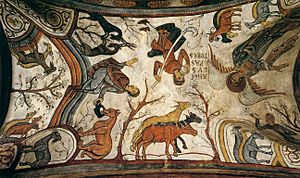Annunciation to the shepherds facts for kids
The annunciation to the shepherds is a famous story from the Bible. It's found in the book of Luke 2. In this story, angels appear to a group of shepherds and tell them the exciting news that Jesus has been born. This event is a popular subject in Christian art and in many Christmas carols.
Contents
The Story from the Bible

The Bible tells us that shepherds were watching their sheep in the fields near Bethlehem at night. Suddenly, an angel appeared, and the shepherds were very scared!
But the angel told them not to be afraid. He said he had wonderful news for everyone: "Today in the town of David a Savior has been born to you; he is the Messiah, the Lord." The angel also gave them a sign to look for: "You will find a baby wrapped in cloths and lying in a manger."
Right after this, many more angels appeared. They praised God, saying, "Glory to God in the highest heaven, and on earth peace to those on whom his favor rests."
The shepherds decided to go to Bethlehem to see this amazing thing. They found Mary, Joseph, and the baby Jesus lying in a manger, just as the angel had said. This moment is often called the adoration of the shepherds.
The Story in Art

For a long time, the annunciation to the shepherds was usually shown as a small part of a bigger Nativity scene. But around the 800s, artists started making it its own separate painting or artwork.
In Byzantine art (art from the Eastern Roman Empire), and still in Eastern Orthodox icons today, you often see the shepherds in the background of a Nativity scene. They are usually on the right side, while the Three Magi (wise men) are shown approaching on the left.
Many Western artists also show the shepherds in the background. For example, in Domenico Ghirlandaio's 1485 painting of the Adoration of the shepherds, you can see the annunciation happening in the top left corner.

When artists show the shepherds right next to the baby Jesus, that's called the Adoration of the shepherds. This scene is often combined with the Adoration of the Magi. This creates a nice balance in the artwork, with the shepherds on one side and the Magi on the other. This combination also shows that Jesus' birth was important to both ordinary people (shepherds) and important people from far away (Magi).
The landscape in these paintings can be different. Sometimes, the shepherds are on a steep hill, which makes sense because they are often shown above the main Nativity scene. The number of shepherds can also change, but three is common in Western art. Sometimes, dogs are included, like in the painting by Taddeo Gaddi (the one with the red collar).
Famous artists like Abraham Hondius and Rembrandt have also painted this scene. It was one of the first scenes where artists tried to show night-time lighting, especially in the 1400s.
Sometimes, in Renaissance art, shepherds are shown with musical instruments, like in ancient stories about music. One charming old painting even shows the shepherds playing music for the baby Jesus!
Music and Carols
The story of the annunciation to the shepherds is a big part of many Christmas songs and musical pieces.
Christmas Carols
Many popular Christmas carols mention the angels telling the shepherds the good news. The ancient song "Gloria in Excelsis Deo" is one of the oldest.
- "O Little Town of Bethlehem" (written in 1867) talks about the "morning stars together, proclaim the holy birth, / And praises sing to God the King, and peace to men on earth!"
- The German carol "Silent Night" describes how "Shepherds quake at the sight; / Glories stream from heaven afar, / Heavenly hosts sing Alleluia!"
- Charles Wesley's "Hark! The Herald Angels Sing" (from 1739) focuses a lot on this event. It begins:
Hark! The herald angels sing,
"Glory to the newborn King;
Peace on earth, and mercy mild,
God and sinners reconciled!"
Joyful, all ye nations rise,
Join the triumph of the skies;
With th'angelic host proclaim,
"Christ is born in Bethlehem!"
- Nahum Tate's well-known carol "While Shepherds Watched Their Flocks" (from 1700) is entirely about the annunciation to the shepherds.
- Other carols like "The First Nowell", Angels from the Realms of Glory, and "Angels We Have Heard on High" also feature this important moment.
- The carol "I Heard the Bells on Christmas Day", written during the American Civil War, talks about the idea of "Peace on earth, good will to men" in a message of peace.
In Popular Culture
The famous phrase "Peace on earth, good will to men" has been used in many different ways.
- For example, Samuel Morse, who invented the telegraph, used this line in his farewell message in 1871.
- In the classic TV special A Charlie Brown Christmas, Linus van Pelt recites the story of the annunciation to the shepherds word-for-word. He explains that "that's what Christmas is all about, Charlie Brown".
- Even in funny songs, like "I Yust Go Nuts at Christmas", the line "Peace on earth, good will to men" is used to show the difference between the peaceful meaning of Christmas and the sometimes crazy way people celebrate it.
Images for kids
-
Jules Bastien-Lepage, The Annunciation to the Shepherds, 1875
-
Carl Bloch, The Shepherds and the Angel, 1879
-
Henry Ossawa Tanner, Angels Appearing before the Shepherds, 1910
See also
 In Spanish: Anunciación a los pastores para niños
In Spanish: Anunciación a los pastores para niños
- Chapel of the Shepherds' Field









